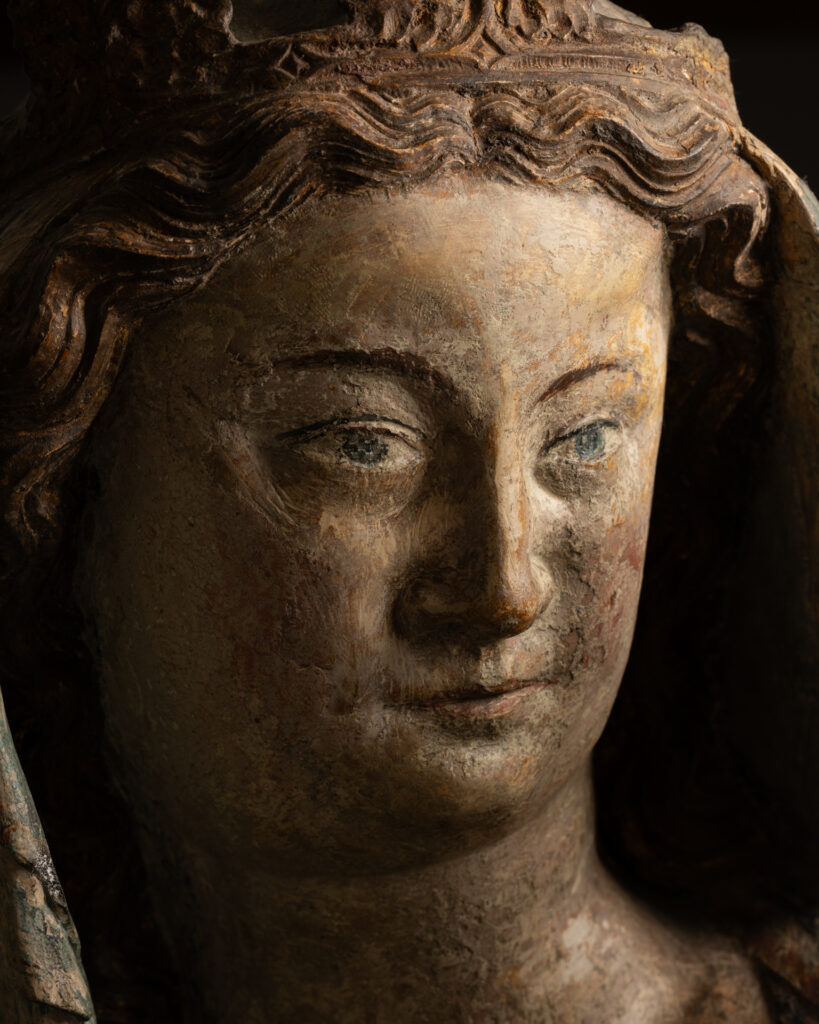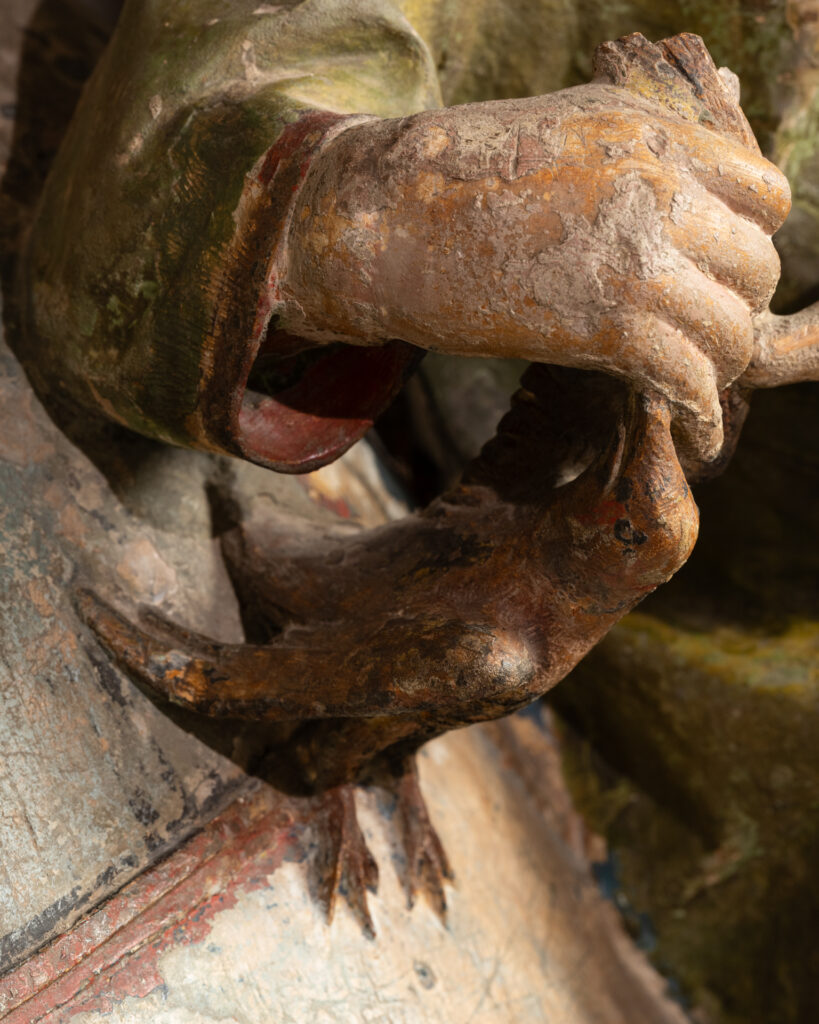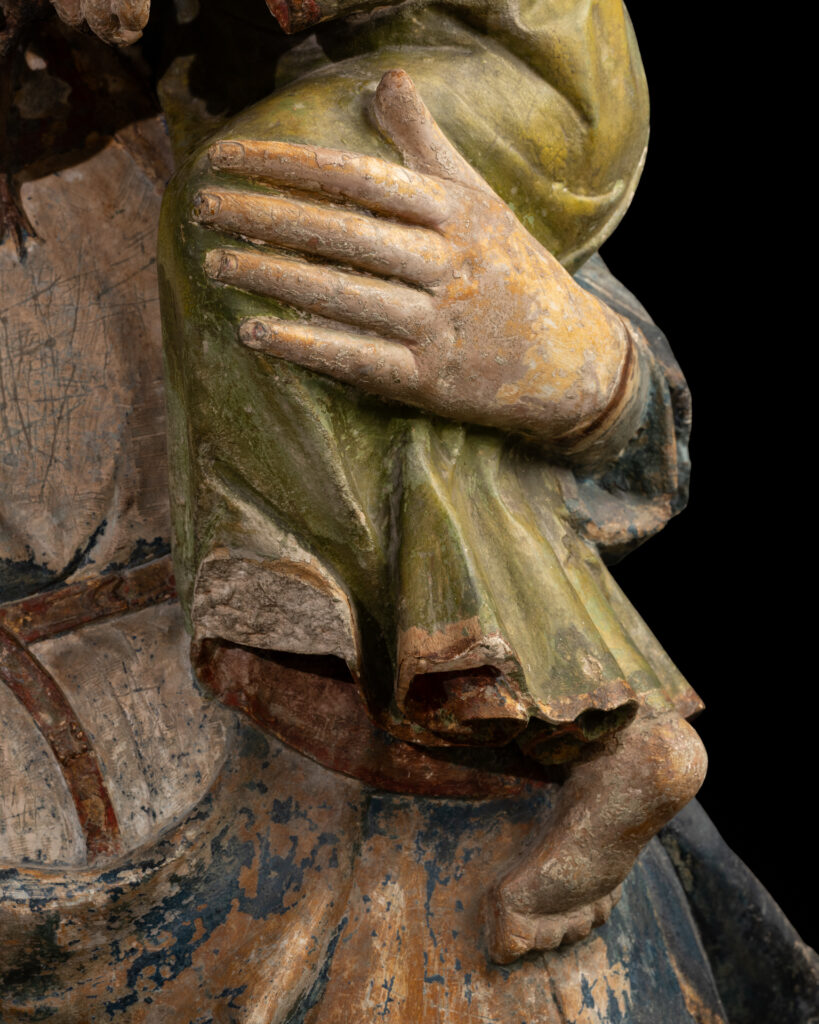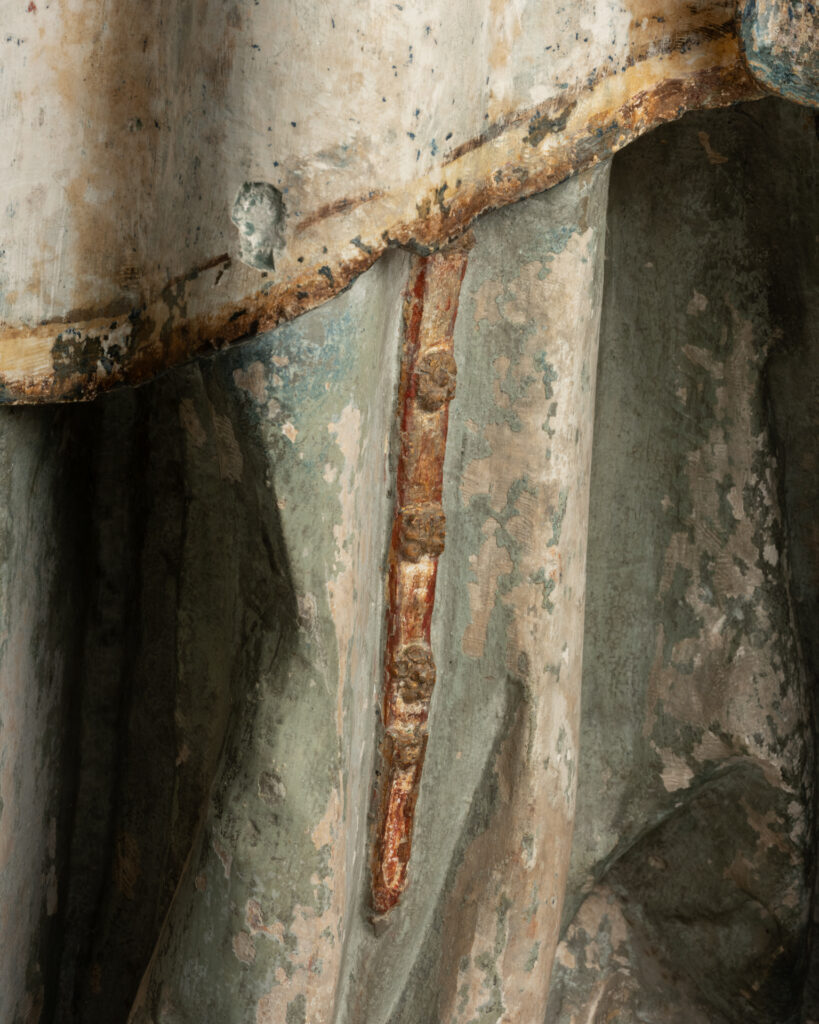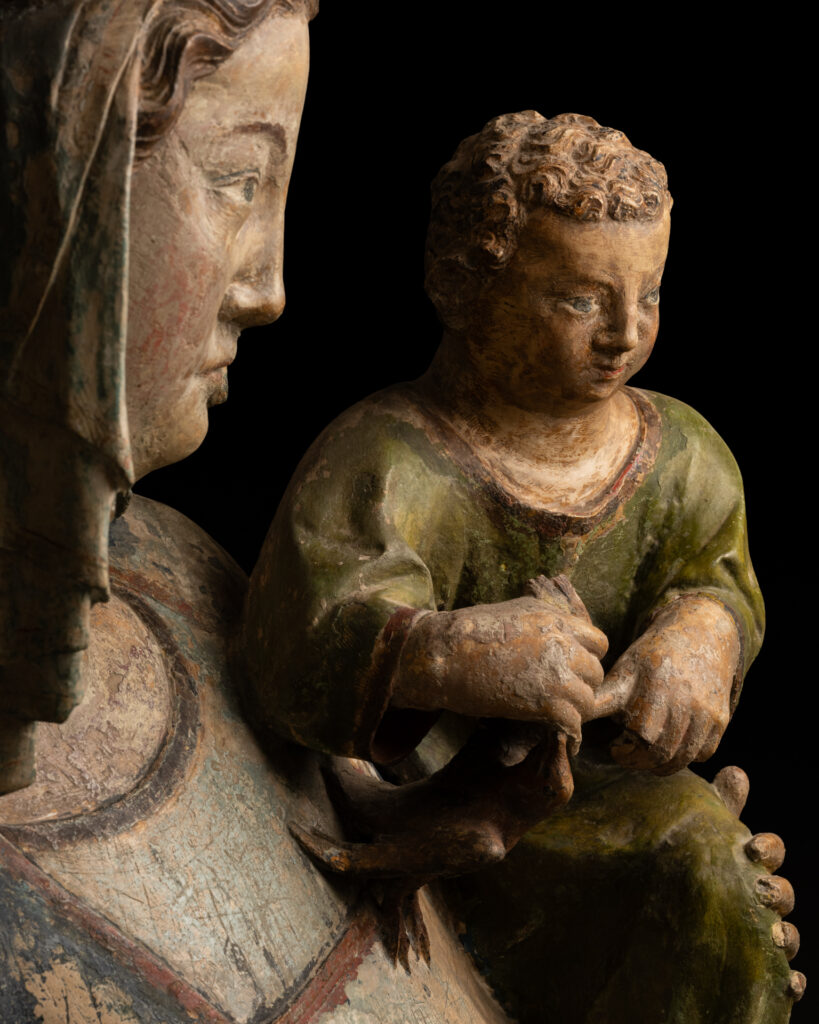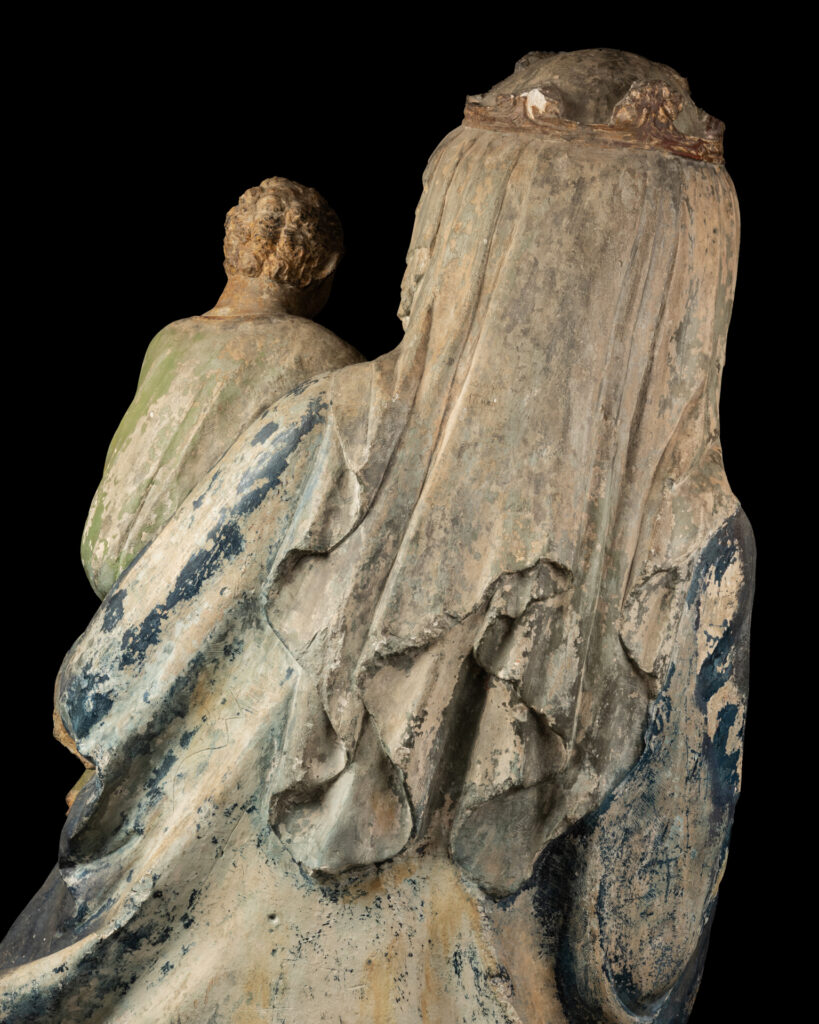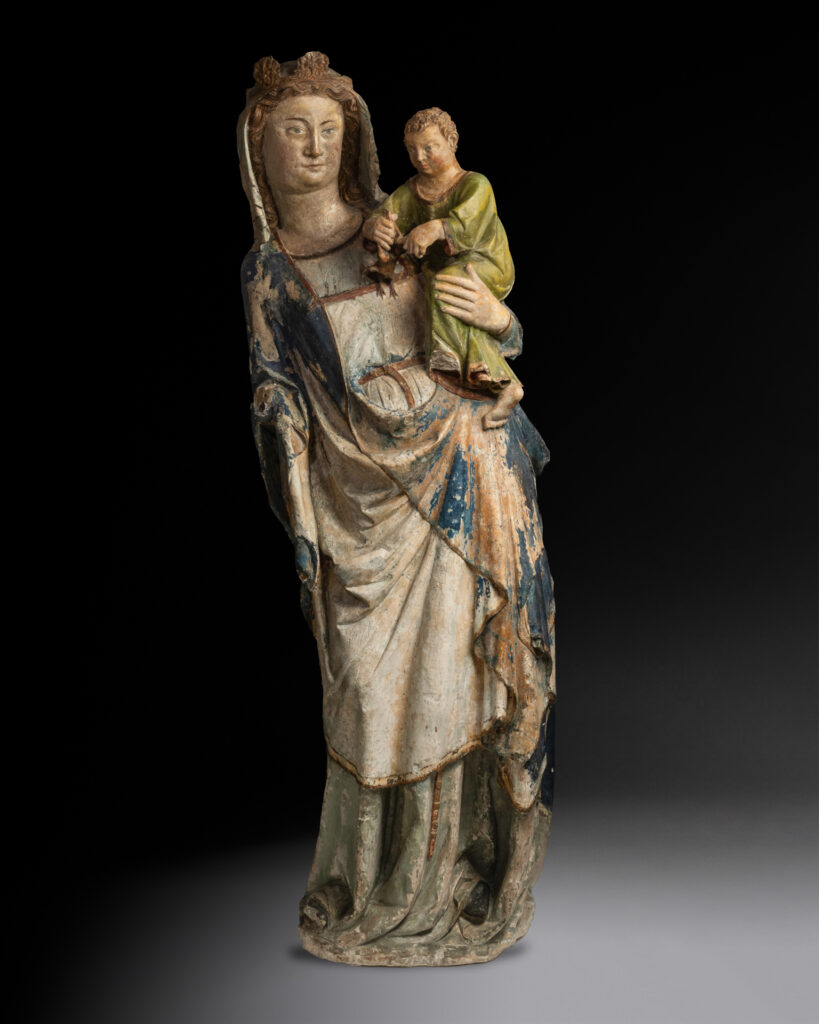The sculpture is classified as a historic monument under the title of object by decree of October 16, 1964.
A true gem of Gothic statuary, the Virgin and Child of Cirey-sur-Vezouze commands admiration for its refinement and monumentality. Standing 171 cm tall, with a strongly elongated silhouette and in contrapposto, it is one of the most impressive sculptures in Lorraine from the first third of the 14th century, contradicting traditional descriptions of this type of work, which use terms such as compact, stocky, or robust. The work is influenced by the “courtly” sculpture of the Ile-de-France region at the end of the 13th century, notably by its exaggeratedly curvilinear silhouette, its cloak rising up like an apron at the front of her dress, and the iconography of the child holding a bird. However, it also borrows its distinctive features from the Lorraine School: thick necks, shield-shaped faces, almond-shaped eyes, and protruding ears for the Child. Preserved until the early 19th century in the abbey church of Haute-Seille (Meurthe-et-Moselle), a subsidiary of the famous Morimond Abbey, it bears witness to the central place of Marian iconography in 14th-century Cistercian art. Despite the vicissitudes of the abbey’s history, it is remarkably well preserved.
Carved in high relief from a single large block of fine-grained limestone, this majestic Madonna stands in a strong contrapposto pose, representing a moment of great tenderness. She carries the infant Jesus on her left hip, dressed in a long tunic and pointing with his index finger (now missing) at a small bird that he holds firmly in his right hand. This iconographic detail, inherited from Parisian Marian imagery, conveys both the innocence of the Child and a premonition of his Passion, as birds are traditionally associated with sacrifice. The Mother of God is wearing a short veil and a crown of fleurons that frame her full, broad face with its pensive expression, surrounded by beautiful wavy hair. Her right arm was originally free from two panels of her cloak, which fell in cascading folds that are now uneven. The inner panel of the cloak is raised diagonally over the front of the dress. It largely conceals a belt with rosette motifs, a clothing attribute widely used in 14th-century iconography and considered a symbol of the Virgin’s virginity. The refined network of folds in the drape of the cloak, whose edges are suggested by a delicate border, accompanies, with a fairly discreet relief, the deep hollows of the pleats in the lower part of the dress.
Although uneven, the reverse side is extremely well executed, with a skillful interplay of short folds and lateral pleats in the cloak that highlight the graceful, curvilinear silhouette. In places, the sculpture has at least four layers of polychromy, reflecting the care taken over the centuries to preserve this very important religious object.
The Virgin and Child of Cirey-sur-Vezouze stands out as a rare example of 14th-century Lorraine art. At that time, the model of the Virgin standing with her Child became established, gradually replacing the older iconography of the Mother of God seated in majesty. In 1970, art historian Josef Adolph Schmoll linked this work to Lorraine productions, comparing it to workshops active in southern Champagne and northern Burgundy, particularly that of Mussy-sur-Aube. He cites it among a small group of statues of the same inspiration, while emphasizing the uniqueness of Lorraine, which remained largely impervious to Burgundian and Champagne influences. In his comprehensive repertoire published in 2005, Schmoll refines his analysis and definitively classifies the Virgin of Cirey among the so-called “zentrallothringischen” Virgins, produced in workshops in the Metz region. These sculptures are distinguished by their simplicity: a draped apron falling over the front of the body, tightened at the waist by a belt and held on the chest by a cord with tassels. The Virgin of Cirey perfectly illustrates this style, which Schmoll dates to around 1335-1340, comparing it to the Virgin of Munster, dated 1315-1320.
Our Virgin and Child comes from the Cistercian abbey of Haute-Seille, founded in 1140 in the diocese of Toul, on the lands of the bishopric of Metz. Its creation is linked to Countess Agnes of Langstein, sister and vassal of Bishop Stephen of Bar. Haute-Seille was a direct subsidiary of Morimond Abbey, one of the four great daughters of Cîteaux, along with La Ferté, Pontigny, and Clairvaux. Founded in 1117, Morimond occupied a strategic position, both geographically and spiritually, and served as a starting point for Cistercian expansion into the Empire and Central Europe. It was from there that the “white monks” of the Burgundian abbey of Theuley, itself under the authority of Morimond, set out to found Haute-Seille. Tradition also highlights the role of Saint Bernard of Clairvaux, whose ties with Bishop Stephen of Bar fostered the birth of this community.
From the 8th century onwards, the Virgin Mary became a spiritual model for monks: Mother of God and mediator with Heaven, she embodied purity and spiritual life. The Cistercians held her in particularly high esteem. For them, Mary reflected their ideal: combining action and contemplation in a quest focused on Christ. All their churches were dedicated to her, as an institutional seal of this devotion. In Haute-Seille, this fervor took concrete form at the end of the 14th century with the creation of the brotherhood of “the Annunciation of Our Lady.” Its seal shows the crowned Virgin Mary seated with the Baby Jesus and holding a lily, symbol of purity and spiritual royalty. However, this Marian cult created tension with Cistercian austerity. The abbeys of the order sought to be sober: clean lines, simple plans, materials reduced to the essentials. In 1134, the General Chapter prohibited all sculpture and decoration, so that nothing would distract from God. And yet, the image of the Virgin and Child naturally found its place in this simplicity. It does not distract, it guides: the tenderness of the Mother and Child becomes a support for meditation, a path to the mystery of the Incarnation.
The abbey church of Haute-Seille, of which a few remains still stand, illustrates this contrast well. Built in pink and gray sandstone and laid out in the shape of a Latin cross, it stood on a rectangular plan with clean lines. Visitors would pass through the Romanesque portal with its five large arches, still visible today, and discover the monumental Virgin and Child in the sober light of the building. Its impressive dimensions dominated the space, touching both the heart and the mind, and transforming the austerity of the stone into an impulse of devotion. Our Virgin and Child is one of the largest examples of Lorraine Virgin and Child sculptures listed in J.A. Schmoll’s catalog. The remarkable preservation and condition of this work seem miraculous, given that the history of Haute-Seille Abbey has been marked by vicissitudes and vexations. A recent article indicates that it underwent periods of devastation in 1284, 1385, and 1420, then was destroyed during the war between Charles V and France around 1556. In 1635, the monks were forced to abandon their ruined monastery. A symbol of the abbey in the 14th century, the statue itself seems to have suffered from these trials: tradition has it that it was found in December 1766 at the bottom of a nearby pond, since called “the Virgin’s Pond.” Her return was seen as a miraculous rediscovery, and she was then given a place in a church rebuilt in the classical Baroque style in the 18th century.
But the upheavals of the French Revolution put an end to this renaissance. The abbey was pillaged in August 1789, then declared national property. Its furnishings were dispersed in 1791, with some residents of Tanconville even obtaining relics and religious objects for their church. Put up for sale in December of the same year, the abbey found no buyer; it was rented, then gradually sold off and divided up. By the early 19th century, only ruins remained. Interest in the site was only revived in the 1830s, with the emergence of historic monument protection. Rough excavations revealed sarcophagi, bones, fragments of clothing, medals, and sculptures, including a Saint Catherine and a Saint Sebastian, now preserved in the Pays de Sarrebourg Museum. After extensive historical research in the 19th century, the site was finally listed in the supplementary inventory of Historic Monuments in 1927.
Paragraph
As for our Virgin and Child, it was transferred in 1821 to the private chapel of Notre-Dame-de-Pitié in Cirey-sur-Vezouze. In the first half of the 20th century, it came into the possession of an antique dealer in Nancy and has since belonged to his descendants. Its high artistic value and heritage interest were officially recognized in 1964, when it was classified as a historic monument (decree of October 16, 1964). The Madonna of Cirey-sur-Vezouze is an exceptional and extremely rare example of the Cistercian tradition of Virgin Mary statues, the most famous example of which is the Virgin and Child dating from the late 13th century, preserved at Fontenay Abbey.
With its elegance and monumentality, the Virgin and Child of Cirey-sur-Vezouze stands among the ruins and across the centuries like a fragment of eternity. It embodies both the memory of Haute-Seille and the spiritual fervor of the monks who admired it. Even today, its silent gaze continues to invite contemplation.
Expertise of Elodie Jeannest de Gyvès, sculpture expert, member of the SFEP.
